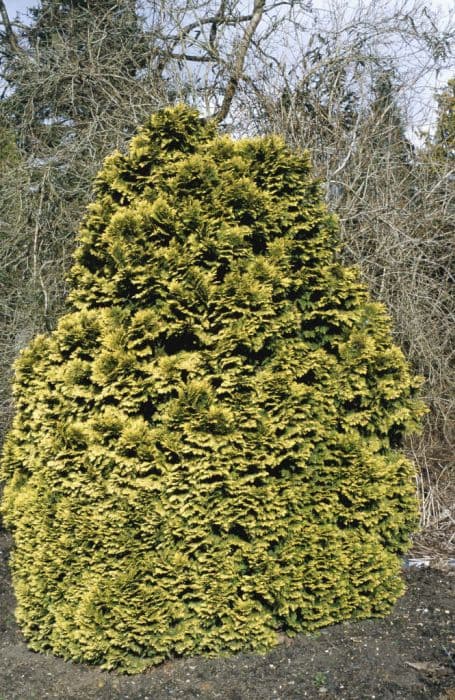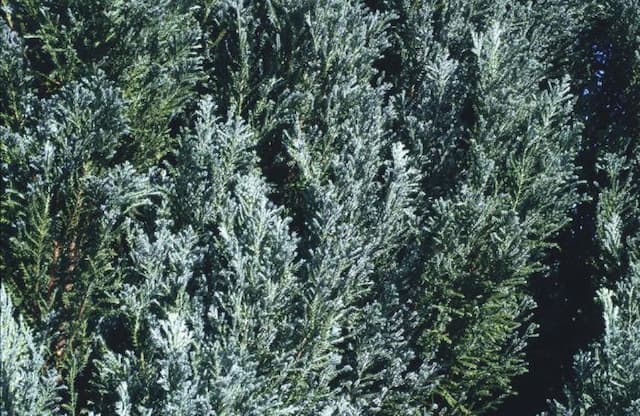Blue Alps Juniper Juniperus chinensis 'Blue Alps'











ABOUT
The 'Blue Alps' is a striking evergreen conifer that features a multitude of dense, prickly foliage with a distinctive blue-green hue. Its needles, which are small and scale-like, closely clasp the branches, creating a somewhat bristly texture that can be quite sharp to the touch. This variety of juniper has a growth habit that forms a sculptural, irregular shape with branches that gently arc and twist, giving it a rugged and natural appearance. The plant displays a dense canopy, which tends to be lush and full, providing an excellent visual barrier or focal point in landscapes. During the colder months, you might notice a subtle change in the color intensity of the foliage, sometimes acquiring a more pronounced silvery-blue cast. The plant occasionally bears small, berry-like cones that are usually bluish-black, adding further ornamental interest. Overall, the 'Blue Alps' is appreciated for its unique form and the soft, silvery-blue tint of its foliage.
About this plant
 Names
NamesFamily
Cupressaceae.
Synonyms
Blue Alps Juniper, Chinese Juniper.
Common names
Juniperus chinensis 'Blue Alps'.
 Toxicity
ToxicityTo humans
Chinese juniper is not considered highly toxic to humans, but parts of the plant can cause mild irritation and should not be ingested. If someone consumes the berries, needles, or other parts of Chinese juniper, they might experience stomach irritation, diarrhea, or other gastrointestinal symptoms. It's always best to avoid ingestion and keep parts of the plant out of children's reach.
To pets
Chinese juniper is also not highly toxic to pets, but it can still cause mild gastrointestinal upset if ingested. Symptoms of poisoning in pets may include vomiting, diarrhea, and sometimes more severe gastrointestinal distress. As with humans, it's recommended to prevent pets from ingesting parts of the plant to avoid any potential discomfort or health issues.
 Characteristics
CharacteristicsLife cycle
Perennials
Foliage type
Evergreen
Color of leaves
Blue-green
Height
6 feet (1.83 meters)
Spread
8 feet (2.44 meters)
Plant type
Shrub
Hardiness zones
5
Native area
China
Benefits
 General Benefits
General Benefits- Aesthetic Appeal: Juniperus chinensis 'Blue Alps', commonly known as the Blue Alps Juniper, has striking blue-green foliage that adds color and texture to landscapes.
- Low Maintenance: It requires minimal care once established, making it ideal for gardeners who prefer low-maintenance landscapes.
- Drought Tolerance: The Blue Alps Juniper is drought-tolerant, making it suitable for xeriscaping and water-efficient gardens.
- Erosion Control: Its dense growth habit helps to prevent soil erosion on slopes and banks.
- Habitat for Wildlife: It provides shelter and nesting sites for birds and other wildlife.
- Privacy Screen: With its thick foliage, it can be used as a natural privacy screen or windbreak.
- Adaptability: It adapts well to a variety of soil types, as long as they are well-drained.
- Seasonal Interest: It retains its color throughout the seasons, offering year-round interest in the garden.
- Formal and Informal Landscaping: Versatile in use, suitable for both formal hedges and informal garden settings.
- Scale and Proportion: Can be used to balance garden compositions with its medium to large scale.
 Medical Properties
Medical Properties Air-purifying Qualities
Air-purifying QualitiesThis plant is not specifically known for air purifying qualities.
 Other Uses
Other Uses- Windbreaks – Juniperus chinensis 'Blue Alps' can serve as an effective windbreak due to its dense foliage, offering protection to gardens and landscapes.
- Topiary – This plant can be shaped into various forms, making it suitable for topiary gardens and artistic garden displays.
- Bonsai – 'Blue Alps' is often used in the art of bonsai due to its aesthetic appearance and adaptability to pruning and training.
- Erosion Control – The plant's root system helps to stabilize slopes and prevent soil erosion in vulnerable areas.
- Habitat for Wildlife – Provides shelter and nesting sites for birds and other wildlife in the garden.
- Privacy Screening – Grows densely and can be used to provide privacy in residential gardens and landscapes.
- Gin Flavoring – While not used medicinally, the berries of some Juniper species can be used to flavor gin; however, consult experts as not all Juniper berries are safe for consumption.
- Photographic Subject – Their unique foliage and shape make them an interesting subject for photographers, especially in winter landscapes.
- Garden Themes – Works well in Asian-themed gardens to provide an authentic feel, due to its origin and typical use in Asian garden design.
- Craft Material – Fallen branches and berries can be used in crafting decorative items and wreaths, especially around the holiday season.
Interesting Facts
 Feng Shui
Feng ShuiThe Chinese juniper is not used in Feng Shui practice.
 Zodiac Sign Compitability
Zodiac Sign CompitabilityThe Chinese juniper is not used in astrology practice.
 Plant Symbolism
Plant Symbolism- Protection: Historically, juniper, including 'Blue Alps', has been used to ward off evil spirits and negative energies, serving as a guardian and protectant for homes and individuals.
- Purity: Juniper berries are known for their cleansing and purifying properties, used in various traditions to cleanse both the air and spirit, symbolizing the desire for cleanliness and health.
- Healing: Juniper is associated with healing, not just due to its antiseptic properties in folk medicine, but also symbolizing the healing of emotional wounds and support during recovery processes.
- Endurance: The hardiness and evergreen nature of the 'Blue Alps' signify endurance and the ability to thrive in harsh conditions, relating to resilience in the face of adversity.
 Water
WaterThe Blue Alps Juniper requires moderate watering, with more attention during the active growing season in spring and summer. Typically, it should be watered every 5 to 10 days, depending on the soil moisture and climate conditions, giving it about 1 to 2 gallons of water each time. Ensure that the soil drains well, as junipers do not like to stand in water. During the winter months, you can reduce watering since the plant's growth slows down and it requires less moisture. Always check the top inch of soil for dryness before watering to prevent overwatering, which can lead to root rot.
 Light
LightBlue Alps Juniper thrives in full sun, where it can receive direct sunlight for at least six hours a day. The best spot for this plant would be in an open area, away from tall buildings or trees that could create excessive shade. Some light shade is tolerable, particularly in extremely hot climates, but the plant's color and growth are optimal when placed in full sun.
 Temperature
TemperatureBlue Alps Juniper is hardy and adapts to a wide range of temperature conditions. It can withstand temperatures as low as -10°F and as high as 100°F. The ideal temperature range for vigorous growth is between 60°F and 80°F. This juniper variety has a good tolerance for cold and can survive winter conditions without special care in most temperate regions.
 Pruning
PruningPruning Blue Alps Juniper is essential to maintain its attractive shape and encourage dense foliage. Prune in late winter or early spring before new growth starts, reducing the longest shoots and shaping as desired. It's typically not necessary to prune more than once per year, unless you are training the plant or correcting damage. Regular pruning also helps prevent disease by increasing air circulation within the plant's foliage.
 Cleaning
CleaningAs needed
 Soil
SoilChinese Juniper 'Blue Alps' thrives best in well-draining, sandy-loam soil with a slightly acidic to neutral pH of around 6.0 to 7.0. A good mix for this conifer would be one-third sand, one-third garden soil, and one-third peat or compost to retain some moisture yet allow excess water to drain away efficiently.
 Repotting
RepottingChinese Juniper 'Blue Alps' generally requires repotting every two to three years to refresh the soil and prevent root-bound conditions. Repotting is best done in late winter or early spring before new growth begins.
 Humidity & Misting
Humidity & MistingChinese Juniper 'Blue Alps' prefers a dry to moderate humidity level. As a drought-tolerant plant, it does not require high humidity and can thrive well in typical outdoor humidity ranges.
 Suitable locations
Suitable locationsIndoor
Provide bright light, avoid overwatering, ensure good air flow.
Outdoor
Plant in sunny spot, well-draining soil, water when dry.
Hardiness zone
4-9 USDA
 Life cycle
Life cycleThe 'Blue Alps' Juniper, a cultivar of Juniperus chinensis, begins its life cycle with seed germination, often requiring a period of cold stratification to break dormancy. Once germinated, the seedling goes through a juvenile phase where it establishes roots and begins to grow foliage characteristic of its cultivar, with blue-green needle-like leaves. As the plant matures into the adult phase, it develops a woody stem and adopts a pyramidal or conical shape, continuing to produce dense, scale-like foliage. In the reproductive phase, which can occur after several years, it produces separate male and female cones on the same plant, with pollination typically relying on wind dispersal. After fertilization, the female cones develop into berry-like structures called juniper berries, which contain seeds for dispersal and new plant colonization. The 'Blue Alps' Juniper can live for many years, becoming more expansive and pronounced in its picturesque, shrubby form as it ages.
 Propogation
PropogationPropogation time
Late Winter to Early Spring
The Chinese Juniper 'Blue Alps' is commonly propagated by semi-hardwood cuttings. This practice is typically done in late summer when the new growth has started to mature and harden somewhat. A cutting, usually about 4 to 6 inches (10 to 15 centimeters) in length, is taken from a healthy, disease-free branch. It's essential to make a clean cut and remove the lower needles from the cutting to expose the nodes. The base of the cutting is then dipped in rooting hormone to encourage root development and planted in a well-draining rooting medium. The cutting should be kept in a warm, humid environment, ensuring the soil remains moist but not waterlogged until roots have successfully formed, often several weeks to a few months later, depending on conditions.









